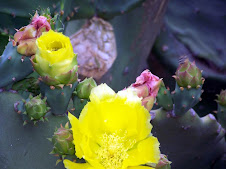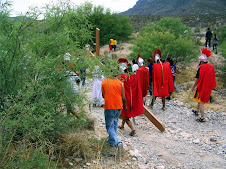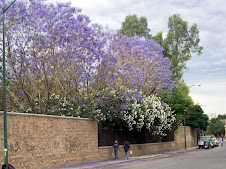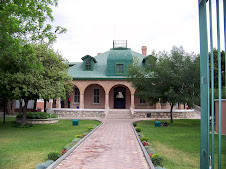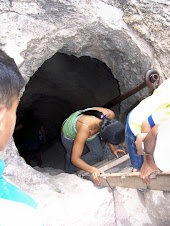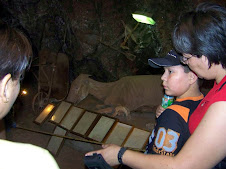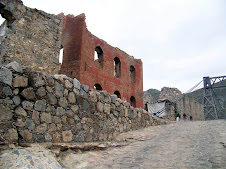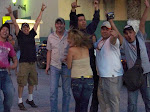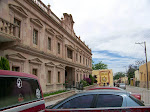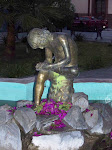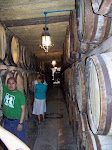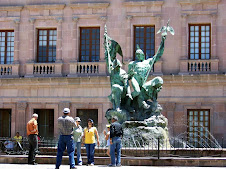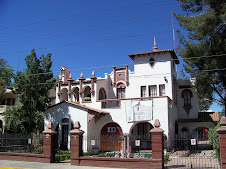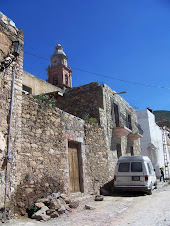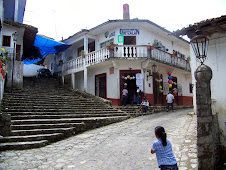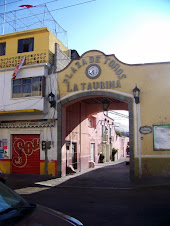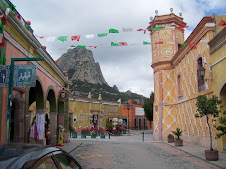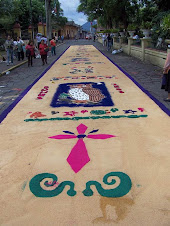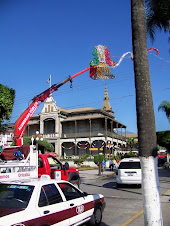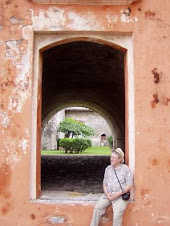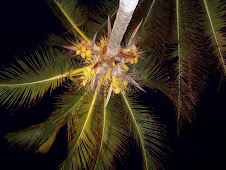PART ONE: LANGOSTINOS IN POTRERO
My brother and I drove a 2003 Toyota Corolla approximately 3,000 miles through Mexico over two weeks. We saw 14 cities, with several side-trips and at least one adventure, and the entire vacation cost us about $1,200 each, including gasoline, tolls, and personal shopping for a few friends. Is Mexico a great travel experience on the cheap, or what?!
We left Corpus Christi about 8:00 a.m. for Tampico or Tuxpan (whichever we could make by nightfall)
. The border crossing took a bit longer than expected since there were more people temporarily importing their vehicles than was usual at this
aduana. The road to Tampico is straight and, for the most part, a good one, though as is usual with Mexican highways, between the
topes and
doble-remolques (a.k.a. "sleeping policemen" and piggybacked trailer rigs, respectively), you really cannot make good time on most Mexican roads. Figure on 50 mph on the average, which is about what the speed limits are anyway. We took the "cut-off" road before Victoria, going toward the Gulf through Soto la Marina.
My theory has always been that if one is heading for any destination east of Mexico City -- even if it is in a mountainous region, like Xalapa -- the coastal highway, #180 all the way after La Coma is preferable to going inland through Tamazunchale. It's a straight shot down, whereas the inland route beyond Tamazunchale is one
camino sinuoso after another. We had enough hairpin curves in front of us as it was, planning to go through the Sierra Gorda, 177 miles with over 460 curves, from Bernal to Jalpan, with Xilitla and Las Posas inbetween. Still, we only made it as far as Tampico, which was kind of nice since I had never stopped there, only passed through a half dozen times.
Was
I surprised -- no, make that delighted. I'd always thought Tampico was hot, humid, and sleazy. Although we liked having air conditioning in our balcony room at the Posada del Rey, the city wasn't all that uncomfortable, and we didn't see anything sociopathic going on. We took dinner that night, and breakfast in the morning, at the Elite a couple of blocks away. Terry liked his
comida mexicana, but I was disappointed by my club sandwich, and the breakfasts were pricey from an a la carte menu. Expect to pay at least $50 for a decent double room here, with dining entres in the $6-12 range.
Dean and Yoly Hughson of http://www.tecolutla.com/ suggested we stop off in Tecolutla and buy some fresh, locally-made coconut cookies. I had seen photos of Tecolutla and wanted to visit, but it's off the route and I never had a car when passing the turnoff. We arrived to find a place very much like our South Texas Gulf beaches, thatched
palapas notwithstanding. However, we didn't find any cookies, only a tipsy city trash collector who offered Terry a swig from his bottle of
aguardiente (inexpensive cane liquor, a favorite of poor drunken peoples all over Latin America). By late afternoon, we arrived at Xalapa and spent almost two hours -- on foot -- looking for a hotel I have always heard about but never stayed in, the Posada la Mariquinta. We must have gone by it twice before finding it. None of the locals seemed to know where it was. Surprise! It was just around the corner from the old Hotel California. But the Mariquinta was shut down. Huge disappointment after our wasted effort.
We checked into an old standby, the Principal, just a block off the main drag, Enriquez, and only two blocks from the Cathedral. A room for two there is still about $40, with good firm beds and separate shower and toilet rooms. We wanted to eat at the Fonda, where you can still find a good $5 meal, but as it was Sunday, the place was closed (as was everything on the Callejon Diamante. We did manage to have a superb breakfast there, and at a small table on the balcony overlooking Enriquez. There is no dearth of good restaurants in Xalapa's
centro historico.
Although Xalapa is one of my top favorite places in Mexico, we were in a hurry to get to Coatepec to buy
altura coffee and to Xico to buy their local
mole and see the nearby Cascada Texolo, a waterfall featured in quite a few movies, including
Romancing the Stone. We set out for these right after breakfast and didn't leave Xico until afternoon. I had seen maps showing a highway from Xalapa to Cordoba, via Huatusco. (Incidentally, athough we took three different maps, as well as the big Guia Roja map book, the only map I will ever take to Mexico again is Rough Guide's: it eschews detail for well-delineated roads, including subsidiaries.) The map showed an improved road for about half and a superior road the other half. It was the first half that drove me crazy: lots of S-curves, hairpins, and potholes. Try dodging potholes on a hairpin while trying to pass a slow-moving vehicle just as an oncoming
doble-remolque is coming 'round the bend and heading right at you. I was exhausted by the time we pulled into Cordoba.
An e-pal in Pachuca had pre-sold me on Cordoba, which did not live up to the hype. The people are friendly and helpful -- one cop went out of her way to help us locate a shop that had good coffee "
en grano" (bean) when we'd almost given up finding anything but "
molido" (ground) -- but there just wasn't anything going on. Sure, the prices are reasonable (we paid about $45 for a double), but the budget restaurant situation is abominable. We settled that first night on one of the sidewalk joints 'neath the portales, overate, and were kept up half the night by a self-accompanied crooner with inordinate (undeserved) amplication in a nightclub outside our window.
Breakfast was barely edible, taken at Las Gemelas Antojitos, the one place with
cocina economica in its billing.
Lonely Plant had given it an "Our Pick" rating, but it was nothing but a small, family-run joint, a greasy (plastic) spoon with enameled tables and ditzy waitresses. Worse, the State Art Museum, while containing a fascinating artists' history of the State of Veracruz, had its fine Diego Rivera collection out on loan the month we visited. As my older brother always says, "In Mexico, expect the unexpected."
We set out to find the small, rustic town of Rio Atoyac to the northeast, on a back road to Veracruz. I only knew that the road went through an amusingly-named town on the way, a place called Paso del Macho. We got lost at least three times and when we finally found the road, it took us up to wild rivers including the Atoyac, the town of the same name being something out of a reality TV program: streets that went nowhere, washed out streets, and streets that went up and down like a goat trail. The cascading river is genuinely impressive, but ignore
Lonely Planet's recommendation you stop off for a repast of fresh, locally-caught (or farmed) langostinos. I was expecting "mud bugs" (Cajun: crawfish, or as some say, crayfish), but these were more like a large prawn.
They're best found in the larger town of Potrero, to which we doubled back hastily. At an attractive restaurant with a big veranda where we dined, we found the tasty langostinos. They were not inexpensive at $10 for a plate of five or six, cooked
mojo el agua, or garlic-roasted. Would I get lost three times, almost go off the road in Atoyac, &c. for the local specialty? No. But they're good eating. I prefer shrimp prepared almost any style and even crawfish. And I was hungry: we didn't get to eat until almost three, which set us back for the next leg: to Orizaba.
We both felt
Lonely Planet's description of Orizaba as "more industrial than urbane" was unkind and inaccurate. What's wrong with having a lively main drag separated by a few blocks from the zocalo? We found Orizaba charming. And we actually stayed on the main drag, at the high sounding Gran Hotel de France, actually nothing more than the central patio (Spanish) style inn with rooms on the periphery; in this case, though, they'd been thoroughly remodeled. A double is about $40. At night, you can walk over to the zocalo and hire a marimba band to play a song for two bucks. Or you can shop in the stalls on the edges of the 17th century
parochia or, catercorner, the historic Palacio de Hiero (Palace of Iron), an art nouveau manse designed in the 1890's by the famous A. G. Eiffel, built in his native France, then disassembled, shipped to Mexico, and reassembled plate by plate.
Sadly, the Rio Orizaba, which snakes through the city much like the San Antonio slices up parts of the Texas city of that name, is polluted. They've even posted signs in the parks along the cement-shored-up banks to warn citizens and visitors alike to avoid swimming. October is delightful here. Cool, not cold, but one gathers the impression winters might be harsh at 4,000 feet. The main drag is actually a lot of fun at night. Terry and I were accosted by a secretary for the city government who was eager to practice her English. She even invited us to call on her office in the morning. Talk about friendly! One might live here and spend the cold months someplace along the coast, either big, brassy Veracruz itself or one of the charming villages nearby, including Tlacotalpan and the Tuxtlas.
Next morning, we were off for Tlaxcala. I had been there once, years ago, and had some fond memories, including those of a good hotel for the money, the Alifer, on a hill on the southeast side of the city center. Now, about $58 for two, it is expanding to new wings, possibly entitling the owners to a tax break for an "unfinished building." wOur room was not as nice as the one I had previously, but it was large and had OK beds. (Having injured my back with a compression fracture last summer, I began to notice the usually dismal quality of Mexican beds, usually lumpy matresses with odd bulges that interrupt your sleep when you have to catapult yourself over the bumbs to change position, as I frequently do at night. We found that price seldom equals quality of mattress.)
I showed Terry around the twin plazas, Constitucion and Xicotencatl ("She-co-TEN-cawl," I think it's pronounced). We located an artesanias alley but it was closed, probably until late October, when the Dias de los Muertos festival, now combined with gringo style Hallowe'en, brings back the
chilangos. (Don't get me wrong, I have nothing but respect for the people of Mexico City. Having visited there two years ago, I realized they're not unlike the pretzel vendor I once encountered on the street in Manhattan: when I asked him where Macy's was, he pointed to a building across the street and, lo and behold, there it was! "See, you gotta be tough to live in New York" he said proudly. It was a non sequitur that made perfect sense.)
But the attention Tlaxcala gets from its weekend and holiday infusion of big city folk has made it somewhat crass and aloof. I did not like it as much as I had years ago. Next door to the Museum of Popular Arts and Traditions, however, I located a place I had not visited previously: a very reasonably priced Casa de Artesanias. We bought hand-painted
"Katrina" statuettes, Posada-inspired husband-wife skeletons in fancy dress, sets of two for about $12. The employees wrapped them and boxed them at no additional expense when we said we were driving and didn't want to break them. The place has a wide variety of folk art, highly recommended.both for its pieces and helpful staff. We had a good breakfast at another favorite of mine: the Restaurant Tirol, just up the street from the city's downtown bullring.
We had to kill some time before we wound up in Cuetzalan for their festival. Terry wanted to see Huamantla, having read of its crazy running of the bulls in August, unique in that, of all the imitation Pamplonas in all the world, Huamantla's is probably the only one that, improbably, opens the gates from
both ends of the run. Terry also mentioned a Puppet Museum, so I was ready to go. In my youth, I both made puppets and staged puppet shows. Unfortunately, the museum is disappointing, having only a few pieces of very fine work. Other than its pleasant zocalo, Huamantla is at best a stopover on the way somewhere else. If you get both tired
and hungry, the Balcones Restaurant between the Hotel Centenario (where we stayed, reasonably priced) and the plaza, will do in a pinch. Check out the bar with its collection of bullfight memorabilia. You can also stroll over to the
plaza de toros and museum nearby.
PART TWO: JIM & TERRY'S EXCELLENT ADVENTURE
Deciding to crisscross and double back, we went to Apam (a.k.a. Apan), once the capital of pulque making in the State of Hidalgo (and, importantly, linked by rail to the Federal District), but now a typical modern Mexican city; not my destination, but the closest large town. For years, I had wanted to visit an old hacienda, Tetlapayac, where the Soviet filmmaker Sergei M. Eisenstein shot what has come to be known only as "the Mexican film." Having seen the unassembled raw footage of the project, donated to the Museum of Modern Art by Upton Sinclair, the producer, I became fascinated by Eisenstein's epic love poem to a country he came to almost regard as a second home. Alas, it was not to be. Sinclair pulled the plug and Eisenstein, his photographer and actor-friend went home to Russia and a new culture czar both insensitive to his plight and disinclined to offer him new projects. Stalin would not approve. This explains why the packaging for the Kino Video/DVD release of Gregori Alexandrov's "remastery" of the film, titled
Que Viva Mexico! as Eisenstein wished, bears in the year-of-production as "1931/1979"!
Stark in memory of an exposure to the uncut footage decades ago were the sequences for Eisenstein's anthology film's "Maguey" episode. A gazillion maguey plants; pulqueros sucking up sap from the heart of the plants using a pig gut as siphon; three young
agrarianistas burried up to their shoulders so that the
hacenderos on horseback could trample them afoot. The compositions of the shots and to some lesser extent (given that Alexandrov edited, not S.M.E.) the editing of these sequences were right out of the Eisenstein we came to love with
Battleship Potemkin, Strike, and Ten Days That Shook the World. The old hacienda served as the background for many of the "Maguey" scenes. (Little did I know, it also served as the location of a fairly recent Zorro movie with Sir Anthony Hopkins. And only recently, some filmmakers shot a documentary there about Eisenstein's connection with the place. I have not seen either.)
The "Apam Trip" was our Excellent Adventure. We got lost about six times. We
never thought we would get there. I began to feel guilty for taking us so far out of the way, as Terry did not seem 100% enthusiastic about the venture (or so I imagined). Worse, we encountered a patch of road construction south of Calpulalpan (the city they hated so much they made it unpronouncable). We inched forward at less than 5 m.p.h. and even had to come to a complete stop for half an hour. It was getting later and later, and I kept thinking things like, what is we get there at dark and they've closed. No, no, I thought, we don't even know if they're open to the public in the first place.
When we finally
did arrive in Apam (or Apan, different spellings on different maps), it was a relatively easy thing to ask a shopkeeper if they knew where we could find the Hacienda Tetlapayac, and we were on our way. Or were we? We got lost another six times. We asked young women at rural bus stops, old men on burros, road crews, and we finally wound up at a road to the northwest with a tiny sign: "Tetlapayac." The big front walls are about a kilometer from the highway and a few hundred yards from the small town that grew up since the pulque-distillery days, the coming of filmmakers, and other events. We noticed that there were thriving sheep ranching and not much else.
A young man of about 30 met us in the courtyard, and he kept punching a button on his walkie-talkie to speak with a woman who appeared, soon enough, in the window balcony of the second story, a woman who looked like the
doña and didn't mind that we could hear her voice both from the parapet and the walkie talkie in her nephew's hands. She was, when we finally met her, imperious and proud, not proud of herself but for her family history. She and her nephew told us that the incident depicted in "Maguey" involving the agrarianistas turning on the hacendados only when one of them rapes a young bride-to-be on the eve of her wedding.
The
señora was reluctant even to talk to us until her nephew assured her that we spoke
some Spanish. We would have to make a donation; getting in was free but they had upkeep and such to attend to. The nephew showed us into a bedroom in the far side of the main house, but when the
señora took over, she invited us up to see the bed S. M. Eisenstein actually slept in. (Of course, I am reminded of the famous joke about the tourist buying one of two Pancho Villa skulls, asking the small boy if he hadn't bought that same skull from him just last summer? "O,
si, señor, but this is the head of Pancho Villa when he was a little boy." Nevertheless, I soon saw that it was the master bedroom and had its own bath: Eisenstein was a guest of honor at the hacienda in the 30's, so it's quite likely he was given the best lodging.)
She surprised me by showing her willingness to lie down on the big bed where, she says, Eisenstein slept. Once Terry and I were out of her earshot, he muttered: "She kind of reminds me of Gloria Swanson in
Sunset Boulevard."
"Yeah," I said. "I could just hear her saying, 'Ready for my close-up Mr. DeMille.'"
We had to double back again, this time through Apizaco (a second time), and on the way decided to do something we hadn't planned: stop in Cholula so that we could see some small cathedrals and the ruins at Cacaxtla, both nearby. It was just turning dark when we wound down into the zocalo. The plaza has been cleared on one side for parking, but we arranged for off-street parking a few blocks away courtesy of our hotel, the Posada Santa Rosa. Similar to at least one hotel in Toluca, the Santa Rosa is located inside a shopping arcade, but the rooms are nice for about $50 a night. The eateries along the
portales walkways were pricey, but they came with strolling marimba and other musical buskers, and we were eating too late to have more than a sandwich or some
chilaquiles anyway. The city lights up the cathedral on top of the Tepanaca pyramid so that it displays a stunning backdrop for a stroll along the plaza. So much nicer than the hustle and bustle of nearby Puebla, we thought.
PART THREE: CRISS-CROSSING THE ALTOPLANOIf you approach Cacaxtla relatively fresh from the experience of Chichen Itza or Palenque, you might be disappointed. The excavation itself is not much more than at the Templo Mayor in D.F., but you're not there for temples, you're there for frescos in color, a rare encounter in a Mexican archeological site (certainly the most famous being Bonampak's). Imagine Herculaneum, except that these frescos predate the eruption there in 79 c.e. by centuries. Due to the lateness of the hour, we had to rush through the exhibits, but we were nonetheless treated to the magnificent sunset taken in by modern Mexicans' earliest ancestors. On a clearer day, the view might be like something in Provence or Tuscany. But then, on a
really clear day, you can see the volcanic remains of Ixta and Popo.
We also put in at Tonanzintla, where one of Mexico's most famous churches awaited -- and it
must be seen! The inner decor of the Templo de Santa Maria has been described as "exhuberant." I would say Mexican rococo, as authentic in its way as Frida's corsets, with unselfconsciously passionate executions of the many saints in the Catholic hagiographies, rather like one of those detailed, hand-crafted and painted Trees of Life that are so hard to ship back to the States. (The most magnificent of these is surely in the big museum triplex in Toluca, standing some ten feet and decorated with everything from Adam and Eve to the Four Horsemen of the Apocalypse, with charming Mexican village scenes in-between the catechismic depictions.)
On we went to the city of Teziutlan in the mountains of northern Puebla, not our destination but a place to spend the night in case the hotels in Cuetzalan (pronounced by locals as "Kwet-SAH-lan," incidentally) were full. Tomorrow was the first Sunday in October, which is the highlight of the two-week-long Feria de Cafe y Huipiles (Festival of Coffee and Native Dresses). Tonight, we stayed in an eerily deserted "suite" in the Suites Teziutlan, and in the morning made a return reservation at the more inviting Hotel Colonial a few blocks away. Both were priced at about $45, which appeared to be a set price all over town. We strolled through the public market, just off the square. The people were quite friendly. I had gotten sick on a torta I had in Humantla and was not eating, though I went into an attractive hotel with preserved elegance from bygone times, the Virreynal, and ordered chicken soup at $4 a bowl.
The manager of the Colonial, very friendly, gave us a map to get out of Teziutlan and onto the road to Cuetzalan, requiring us to go south back to Zaragoza before turning off and going more or less north. It was a very long, winding trip. I was glad we had gotten off early in the morning: in Mexico, you can always drop in a
panaderia and get some
pan dulce, then find an Oxxo for coffee. (Oxxo serves very good coffee at a good price, too.) This saves 90 minutes in a restaurant ordering
huevos al gusto or
chilaquiles.) We went to Zaragoza by toll road, took the turnoff as the hotel manager had shown us, and drove up, up, up, through some of the most spectacular scenery we'd seen, until the road winds down into a lovely valley with Cuetzalan built on the hills.
I got out my Ronald McDonald bag. This is a big snarly nylon Mexican market shopping bag -- the kind with the water hose handles. For months, I had collected my Happy Meal toys in plastic bags and had about three of them full of movie tie-in and TV promo kid toys in little plastic bags. When I took my sons by car to Cancun, we drove back via Chetumal, and when we stopped for gas in Felipe Carrillo Puerto I passed out Happy Meal toys to a crowd of small boys who swarmed our car trying to sell us a windshield wash or a pack of Chiclets. They seemed much more pleased by the toys than money. I remembered the smiles on their faces and brought just as many Happy Meal toys this time.
The children of Cuetzalan went wild for them. No sooner would I give one out to one girl, she would bring a friend even if it meant having to catch up with you two blocks away; a brother would tell
his brother and follow you about, and so it went. I must have given out fifty toys in that one town. But they know a lot about commerce here. The festival is as much an
artesanias sellathon as a religious and agricultural celebration. You will be accosted almost every couple of minutes to buy hand-knitted tortilla warmers, planters made of armadillo skins, and huipils -- hundreds of huipiles (skirts). After all, the festival itself is named The Fair of Coffee and Skirts.
The square, which fronts the cathedral, was full of a couple of thousand people, a lot of them sitting in temporary bleachers running out from a stage where
jarocho and
huapango groups -- some very, very good -- belted out
son after
son. The outside of the church was full of costumed
voladores (the flying pole jumpers), with their curious rainbow sun helmets; children all in white, girls on one side, boys on the other; and a few people in
viejo (old man) masks, hand-carved and painted. Ablaze in color, the scene would be fit for a painter. Add to this the smell of copal incense wafting out at you when you enter the church, and the effect is hypnotic and, for me, downright spriritual.
Most of the hotels were, in fact, full, but not
Lonely Planet's backpacker's heaven, Posada Jacquiline. I met the
señora herself in the lobby, where she had a sign reading: "Cuartos, $10 per p." and she said she had vacancies. Nicer places did not. We took a ton of photos, did a lot of shopping, had lunch near the square, and left after about three hours. Cuetzalan is nothing if not photogenic: high, cobbled streets, pastel houses and terra cotta roofs, dramatic sunny blue skies with spun sugar clouds, and unspoiled charm. It might be nice to see it when it's not quite so hectic. But we'd both seen the
voladores, in Papantla, for example, so we were headed back to Tezuitlan and an early turn-in for a long haul in the morning.
The Colonial we thought vastly superior to the Suites Tezuitlan: newer, more attractive, with nice frills and fairly good beds. While I am in the habit of going online to www.allmexicohotels.com for the latest price quotations for Mexican hotels, their star system (in emulation of Michelin, no doubt) is completely unreliable: they give the Suites four stars but the Colonial only three. In our opinion, this should be reversed. Had we not been tired and the streets so bumber-to-bumper (Teziutlan is a very busy city!), we would have sought out the Meson de San Luis, a venerable colonial patio-surrounded by rooms, extremely posh place with rooms going for very little above what we were paying.
But after a snappy breakfast of
panaderia pastry and Oxxo coffee, we headed out. The manager assured us that the mountain roads to San Juan del Rio were impossibly curvy and poorly kept, and that our best, which is to say fastest way to that city was due south on Mexico 129 until we reached the trans-Oriental toll road taking us back through Puebla and, eventually, to the toll road to Queretaro, 57. We kept seeing signs advertising small eateries that boasted of their
pollo frito (fried chicken): "KFC," though the entrepreneurs, perhaps with trademark violations in mind, explained that it was "Kansas" style, rather than Kentucky. We thought this amusing. (We wondered if Kansas actually has some special way of frying chicken that would justify the sleight-of-hand, but, really, what does the average Mexican know about the differences between the two states?) Except for getting lost in the slums of Mexico City -- I am not even sure where we were, Netzahuacoyotl? -- the trip was as brisk as he'd told us. We were paying tolls to avoid pot holes,
doble remolques, and hairpin curves.
PART FOUR: TREASURES OF THE SIERRA GORDA
For some silly reason,
Lonely Planet leaves San Juan del Rio out of its guide altogether, but includes nearby Tequisquiapan. San Juan is pleasant enough itself, and I had read that it was the center of the country's precious and semi-precious gem trading. Undaunted by the fact that the only gem store on the main drag, Highway 120, had a very limited supply of the stone I wanted, a Mexican fire opal, we almost by accident met a woman in an internet cafe who directed her helper to guide us to her mother's place several blocks away. We were let into a courtyard full of plants by an elderly but spry, charming woman who opened up her horde of cut and uncut stones. I had read enough about opals to know that she was quite well versed in her trade, so I bought a small opal for my friend Ellie.
We got a decent room in the cavernous Hotel Portal Royalty (about $45) and took a jewelry store owner's advice on finding a place to eat. It was located under the portales along the main drag plaza, a blocks-long affair with pretty fountains and lots of shady trees, globe lighting, and statuary. It's called The Portales and had great food, moderately priced. There are good places to eat along the portales on the south side of the plaza. They have the local specialty,
borego (lamb). The next morning after breakfast here, we drove over to Tequisquiapan, whose zocalo not only looks like a movie set, it has been used for one quite a few, or so said a tour guide who introduced himself.
We dropped into several establishments to browse and check hotel room prices. Tequis is virtually empty during the week, but on weekends throngs of Queretaro and Mexico City families arrive and pay top peso for rooms and shop the arcades, where, we were surprised to find, most of the wares were Chinese, not Mexican. The difference between shopping for
artesanias here and in a place like Cuetzalan, is that in the latter, indigenous peoples still take part in the fabrication process and they eschew plastic. Something must be wrong in Mexico that a shop would have a Chinese piggy bank, not one of clay such as Mexico has become famous for. But even some Mexican crafts appear to be headed for extinction; I'm told, for example, that the mask makers of Guerrero and Michoacan are not passing on their art to the younger generation, who only want to migrate to the big cities and an almost certain hard live.
Leaving Tequis, we embarked on a drive with spectacular scenery and marked by an estimated 860 turns or curves on a 150-mile stretch to Jalpan. We had intended to stop in Xilitla and perhaps see Las Posas, the bizarre, unfinished home of a British expat who envisioned a house built around pools formed by a rushing spring nearby. But a tropical storm had come in off the Gulf and pumped torrential rains on the mountain villages, making the drive up through the "mission district" of the Sierra Gorda quite hair-raising at times. I was glad I had fairly new tires and good brakes. By the time we actually reached Xilitla, the rain was so hard we decided to leave Las Posas for another trip. After all, Terry has shown it to several friends on at least two earlier occasions.
Jalpan was a delightful discovery, its only drawback high humidity. We found a nice room on the plaza across from the church, the Hotel Maria del Carmen, and ate breakfast in the patio-side restaurant inside the more expesive Mision Jalpan. The rain eventually let up and we explored the small town center. We went to a couple of the missions founded by Frey Junipero Serra, but, frankly, they looked like cookie cutter churches, with basically similar design and materials. It would have been nicer to explore the area's multitudinous caverns and waterfalls. Terry's kind of place.
We were now on the backward leg and had a couple of days to kill. I suggested a stopover in Ciudad Valles so that we could take a nostalgic sidetrip to the old Hotel Taninul, near Tamuin, on the road to Tampico. We found a fair to middlin' hotel, the San Fernando, which at least had a nice courtyard parking lot and a friendly staff. It was about $50 a night. We couldn't find anyplace to eat except the La Troye, next to the Hotel Piña, where we both had stayed on previous trips. I couldn't say much good about my $6 hamburger, but Terry had
puntas de filete (beef tips in sauce) and was pleased.
In the morning we drove over to the sprawling Taninul, something out of another era, still a hot springs resort. Amazing to know a place we visited as children was still open for business: we've seen San Jose de Purua and the Ruiz Galindo (in Fortin) close since our childhood trips. One does these things for nostalgia's sake, but we were only too happy to tip a young man named Elias who proudly informed us that he was the only person on the Taninul staff who spoke decent English. He'd learned it in Georgia on a trip to the States. He showed us back to the swimming pools, including one in a natural cave (closed for the time being because of a landslide that blocked the entrance). I will never forget my visit as a child, enchanted with the very idea of swimming up into a cave.
PART FIVE: REAL AND HOME
Our next night was spent in Matehuala, which has a dearth of good, reasonably priced hotels. So many are trucker and tourist traps on the eastern edge of town, the "motel row." We priced several of these decaying habitations on both sides of the main highway, Mexico 57, turning down one offer because the young man who showed us the tawdry room insisted we should pay him rather than register up front. He had a nervous attitude and a blind eye. We decided to go elsewhere.
On the way out, a uniformed doorman suggested we try a new hotel a few blocks away, on one of the sidestreets leading into the town center. It turned out to be the bargain find of the trip. Because it was off the main drag (where one finds the Las Palmas Midway Inn at $80 a night), the Hotel del Parque http://www.allmexicohotels.com/hotel/del-parque-matehuala/info.php cost us only $50 and was easily the most comfortable, attractive room we found the whole trip, bar none. (Parking in the basement is a little cramped: we had to do a rumba to get the Toyota out in the morning.)
Matehuala turned out to be a fairly good place to shop for a few things: we found masks for $15 each, some
jarocho CD'S and, in the mercado, goat cheese and country chorizo. We also had a great meal at El Chivero, a cabrito joint at the southern end of the main road in. For about $10 each, we got soup or beans and a big cut of moist, tender baby goat, grilled with a side of rice and some corn tortillas. It was one of the best meals we had, and boy, were we stuffed!
In the morning, we were off for an unplanned trip to Real de Catorce, just up the road a piece (and down a long, dusty cobbled road leading up to the old mining town). This was one of two places I had hoped to see on another trip, another year, and stopping here made up for missing the rain-drenched Las Posas. I had heard about the famous mile-long one-way tunnel in and out of Real de Catorce, but it is an experience one must enjoy in person. Cars, minibuses, and delivery pickup trucks line up to get in and out, waiting for a signal from the other end on either side for entry and exit.
Once through the tunnel, we took a wrong turn and wound up on a narrow, gravel road on the other side of the river from the main town, which is built on mountainsides. Most tourists do the wise thing and, after the tunnel, park just outside town, then go on in by foot or local taxi. Unwisely, we drove in and found ourselves in a labyrinth of dusty, rock-paved streets, some with inclines of 45 degrees or more, with barely enough room for parking. At one point on the return trip, we got stalled; Toyotas are front wheel drive, and if one of the tires is caught in a washed out hole in the rocks, the wheels spin but no forward movement is possible. Worse, if the car had slid backwards, we would have gone down one of the inclined side streets. Fortunately, once my brother was out of the car, it found its traction and we were able to proceed.
Aside from touring the Casa de la Moneda, an old mint that pressed silver coins in the 1860's, and the Templo de la Purisma Concepcion, a pretty cathedral, both on the tiny zocalo and perched high on the city's hills, there was little to see or do. The trinket stalls were mostly Chinese junk. We didn't even find a decent restaurant and wound up leaving about an hour or two after our arrival. On a scale of one to four, I would give Real de Catorce about a 2 1/2.
We took the four-lane divided Mexico 57 north as the sun began to set. This is a major highway connecting Monterrey with San Luis Potosi. Our plan was to take the turn-off onto 31, connecting the small town of San Roberto with Linares and our overnight destination, Montemorelos. This latter city has nothing to recommend it, and had we not arrived at twilight, we would have gone on to the border and home. (Little did we realize that the Montemorelos-General Bravo leg of Highway 35 is almost as winding and curvy as the Sierra Gorda route we had taken from Bernal to Jalpan, dotted with pine trees and cut through sheer rock canyons, at times quite beautiful.
I cannot recommend the hotel where we stayed in Montemorelos, or even the restaurant we found on the main drag. The locals are surly and inconsiderate. We were glad when we left the following morning, taking the modern, excellent divided superhighway once we reached General Bravo on into Reynosa and home. We agreed we had been on a very nice trip, and we were glad we "brought money home."



